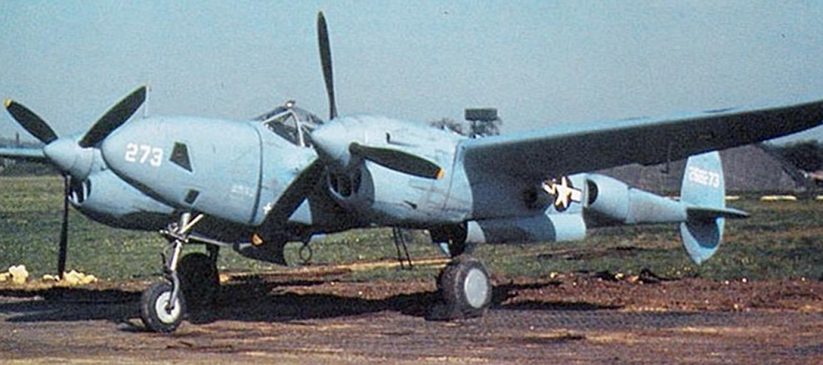
Details:
- Aircraft: P-38 F-5C 42-67245
- Pilot: Lieutenant Ernest E Johnston
- 27th Photographic Reconnaissance Squadron of the 7th Photographic Reconnaissance Group – 8th US Army Air Force
- Lost: 6 April 1944
- Location: Wroughton, Wiltshire UK
Background information:
The F-5C was a photographic reconnaissance version of the Lightning, and was unarmed, being loaded instead with photographic cameras and coloured in a distinctive photographic reconnaissance blue.
At the time of the crash, the aircraft was being operated by the 27th Photographic Reconnaissance Squadron of the 7th Photographic Reconnaissance Group of the Eighth United States Army Air Force. The unit was based at Mount Farm and was busy photographing the northern coastline of France in preparation for D-day.
On 6th April 1944, Lieutenant Ernest E Johnston took off for a camera test in 42-67245. At 25,000 feet, and whilst flying over the town of Swindon in Wiltshire, Lt Johnston noticed smoke which appeared to be coming from the port engine. At this time the fuel pressure gauge was reading 24lbs which was higher than usual, but appeared to be the only instrument not reading ‘normal’.
Lt Johnston then noticed fuel coming from the leading edge cover and streaming across the wing; he called the control tower at Mount Farm and while receiving a vector, saw flames coming from the port engine. He then rolled the aircraft onto its back and baled out safely.
Eyewitness accounts say that he was descending by parachute for what seemed a long time and that the parachute was being violently buffeted by thermals.
The abandoned P38 screamed earthwards and impacted the ground at Artis Farm, Swindon Road, Wroughton, Wiltshire in a field adjacent to where the M4 motorway now runs. The ground conditions at the time were reported to be very wet and one eyewitness claimed that the aircraft was swallowed up by the wet ground.
The official US crash report gives failure in the fuel system somewhere between left wing tank boost pump and carburettor, and therefore states the cause of crash as 100% mechanical failure. The report also states that ‘from the appearance of wreck, left engine was blown out of its mount while plane was still in the air.’
Investigation
Various eyewitness accounts were gathered from 1998 to 2002 which variously gave Artis Farm, Goslings Field and Ladder Lane as the crash site, all of which are correct but describe a large area.
The field in which the wreck was found was, during the war, much larger than it currently is, having been bisected by the construction of the M4 motorway.
For a long while it was thought that the crash site actually lay beneath the motorway.
In 2004, whilst exhibiting in Wroughton as part of the Wroughton History Group Open Day, Daniel and Kevin Hunt of the Wings Museum were approached by a local resident who was a keen metal detectorist. He claimed that he had found pieces of aluminium, with blue paint on them, in field close to the M4 motorway whilst, with the farmer’s permission, metal detecting in a field for historical artefacts.
The man was asked whether he could show Daniel and Kevin where he had found the pieces, which he duly did on 7th April 2012. A search was carried out and small fragments were found which were clearly from a P38 Lightning, and some of which still retained traces of the blue photographic reconnaissance paint finish.
Using deep searching metal detectors, two targets were eventually located close together, possibly representing one engine and nose wheel.
Permission was sought from the landowner for a possible recovery and an application was made to the Ministry of Defence for a licence to excavate the remains of the aircraft. This was duly issued on 28th May 2012.
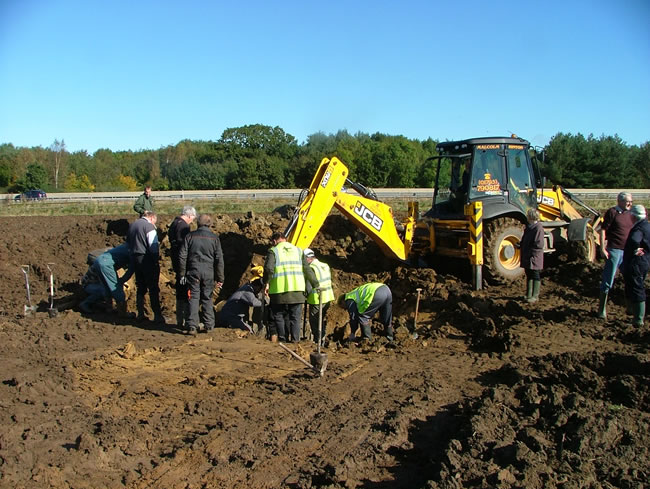
Excavation
The excavation of P38 Lightning 42-67245 took place on Saturday 6th and Sunday 7th October 2012. At this time the field had been recently ploughed.
The weather on the Saturday was fine but the previous day had been rainy and the ground condition was wet and the soil found to be heavy clay.
The excavation began by clearing away the top soil from the site. This was cleaned of any artefacts ready for replacing over the site at the end of the weekend. A JCB was used to achieve this and for most of the subsequent excavation, however, once the main wreckage had been reached, the JCB was replaced with working by hand using spades and trowels.
The first artefact recovered at a depth of 0.6m was a balance weight from the elevators located in the tail of the aircraft. This was found in isolation from any other wreckage, there being no other evidence of the tail section.
At a depth of 1.5m the first substantial piece of wreckage was recovered consisting of part of one of the booms, and containing the American national insignia the ‘star and bar’.
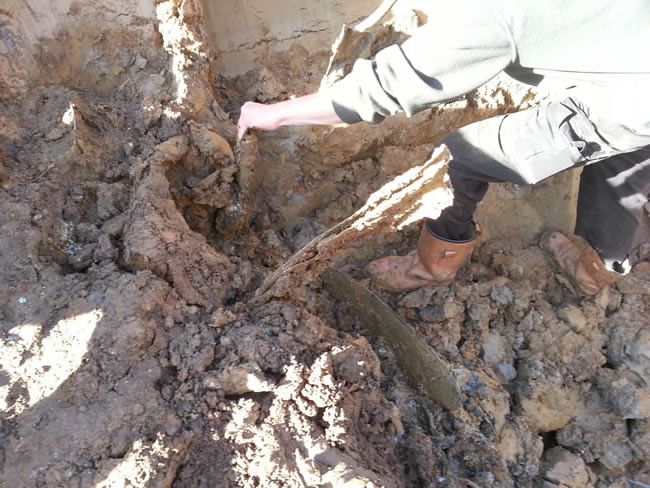
Immediately below and in front of this, at a depth of 1.8m, a single propeller blade emerged which was detached from the propeller hub.
Below this at a depth of 2.0m a second propeller blade was found, this one still attached to the propeller hub.
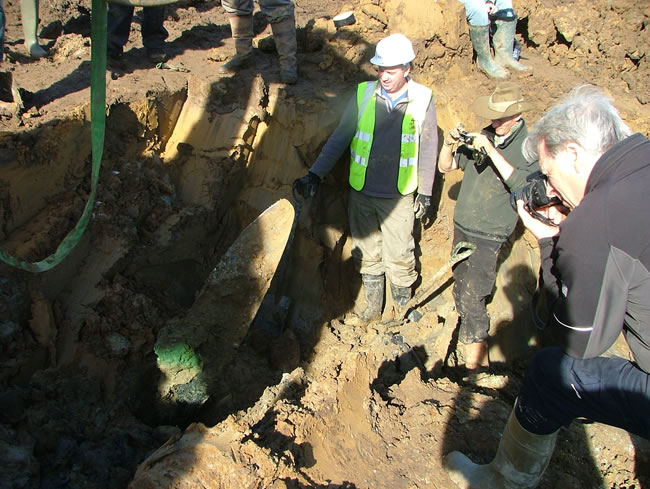
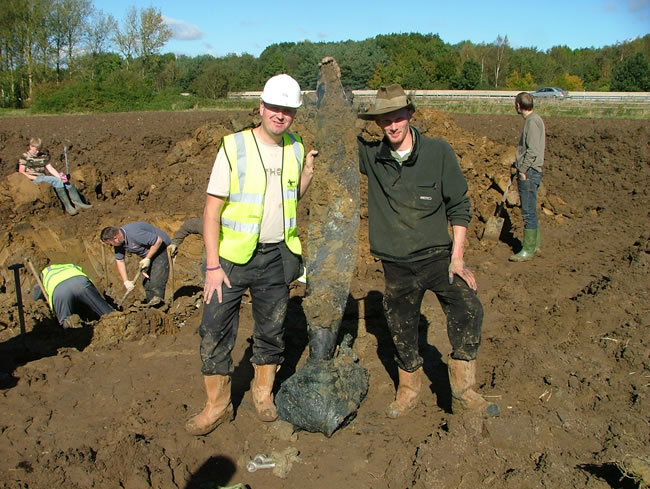
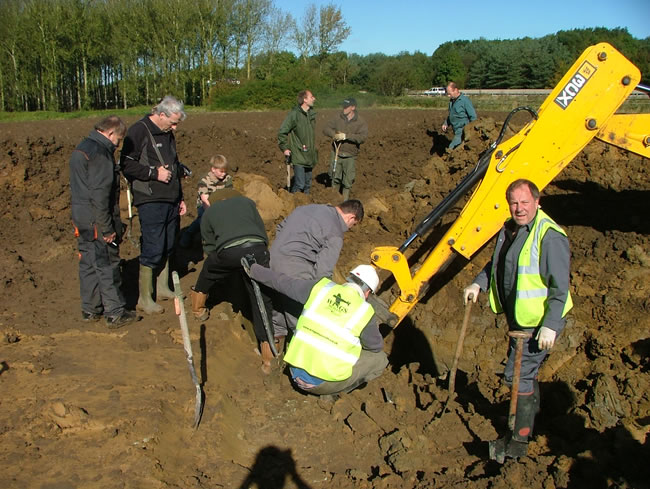
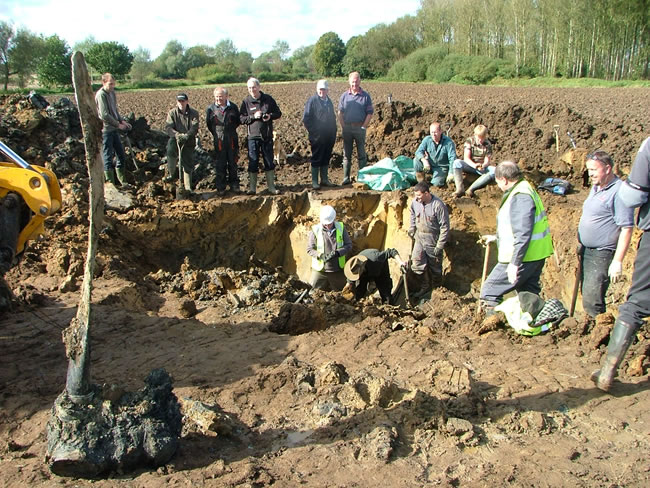
Behind and above this a large section of crumpled boom with the supercharger tangled within was found.
Below the supercharger, an undercarriage leg and tyre was recovered from a depth of about 1.8m.
The remains of one of the aircraft’s two Allison V1710 engines was recovered below this at a depth of 2.4-3.0m. This was the deepest piece of wreckage recovered. The clay below the engine was undisturbed and contained no further wreckage.
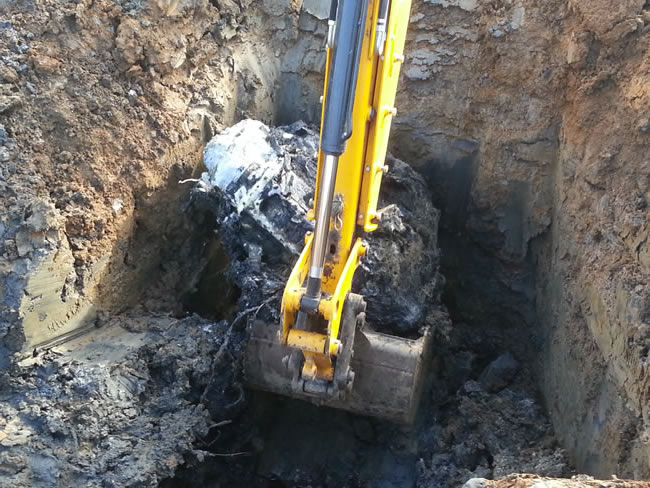
The engine was found to be lying in the ground with the front end tilted downwards at approximately 30 degrees, and roughly facing west, aligning with the M4 motorway.
All of this wreckage was found at the location of the larger of the deep search metal detector readings, and the reading nearer the motorway.
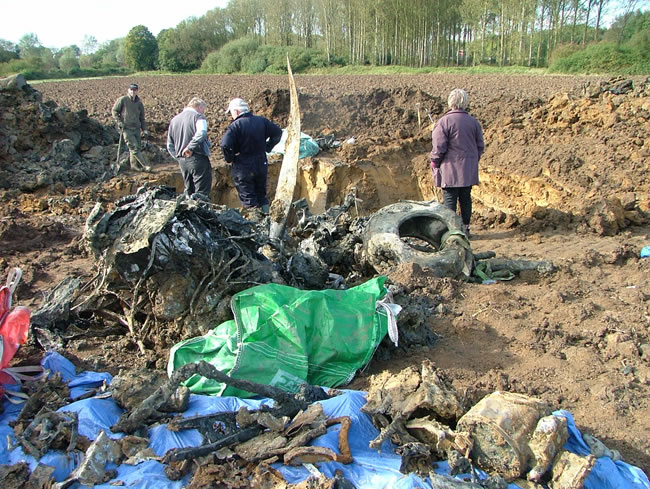
The excavation then moved on to the second reading, and at depth of about 0.8m a part of the cockpit canopy, section of instrument panel (minus instruments) and an instrument face were found.
At a depth of approximately 1.2m a large section of wreckage crumpled into a ball emerged. On removal of this section of wreckage it was found to be the remains of the cockpit floor, with the seat posts, remains of the control yoke, rudder pedals, throttle quadrants and a part of the instrument panel.
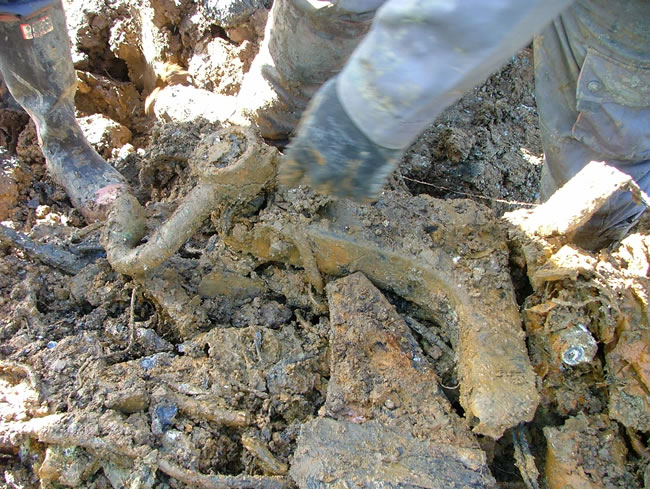
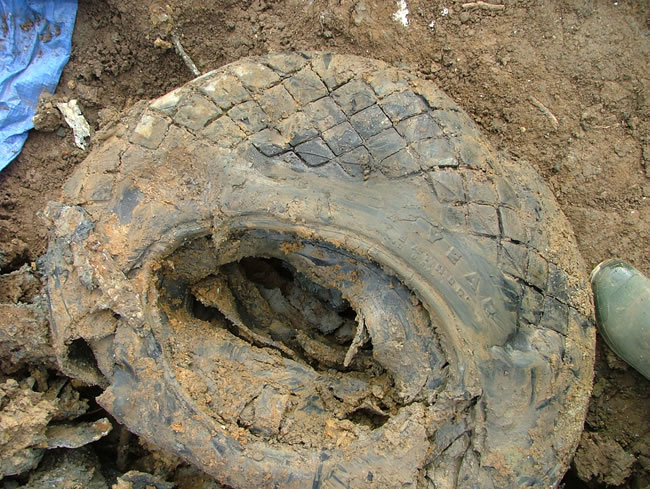
Immediately below this, the nose wheel leg and tyre was found. Remains of three cameras were found below the cockpit at a depth of about 1.8m.
After this the wreckage trail ceased, with undisturbed clay being evident below this.
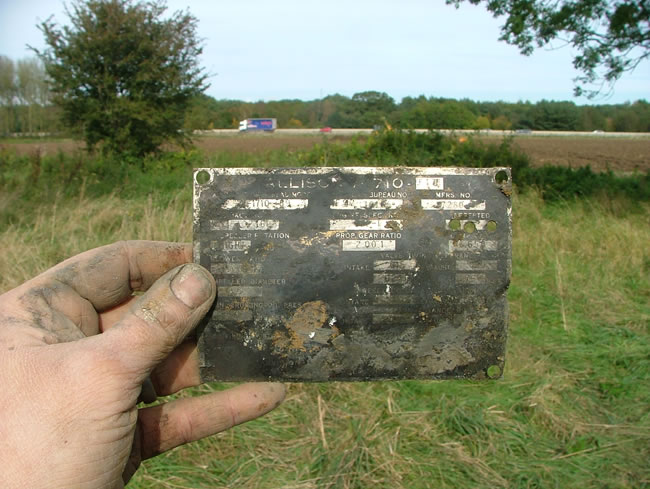
The area which would have corresponded to the second engine and boom was excavated but nothing was found, and no staining was observed in the ground.
This concluded the excavation on Saturday 6th October 2012.
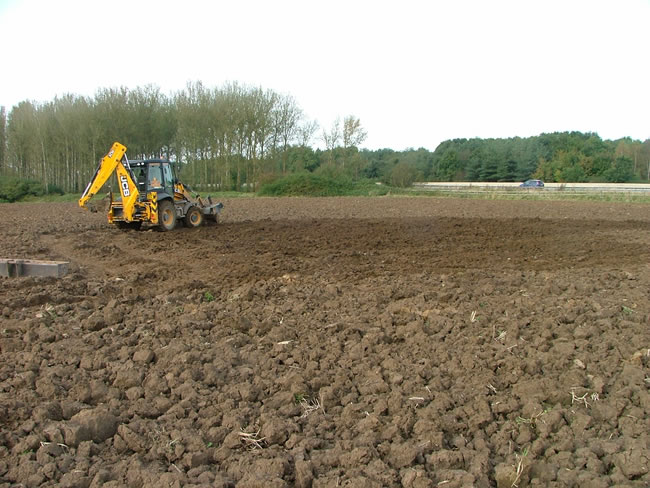
Sunday 7th October was spent going over the spoil heaps and infilling the excavation and reinstating the field.
The wreckage remains were then transported to the Wings Museum at Balcombe in West Sussex. The items will be conserved and displayed in the museum.

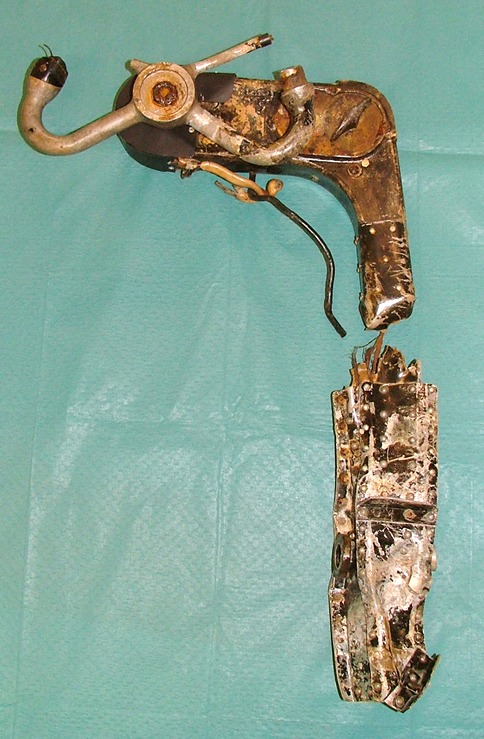
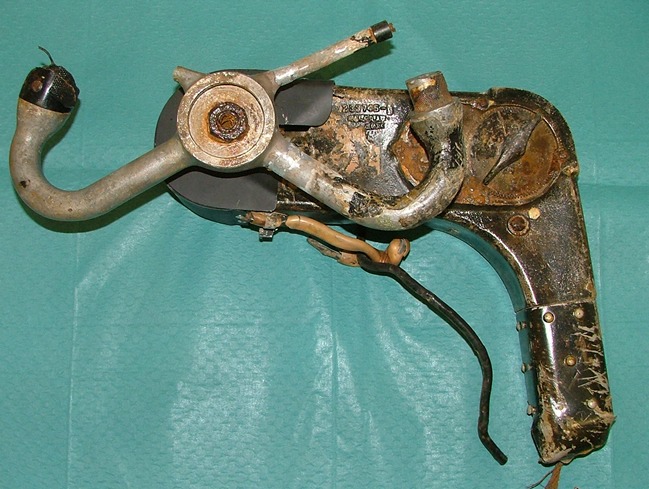
Conclusion
One complete boom, engine and undercarriage leg was missing from the wreckage. As the USAAF crash report indicates that the port engine had been blown off its mountings we can conclude that the engine and boom remains recovered were from the starboard side. We can also verify the original crash report in that not just the engine but the entire port boom must have become detached when the aircraft suffered structural failure whilst still in flight, prior to impacting the ground. Therefore from the position of the starboard engine in relation to the cockpit area we can conclude that the aircraft was travelling in a westerly direction just prior to the impact and that the aircraft probably impacted the ground at an angle of 30 degrees. An eyewitness reports seeing a wing on the surface which is most likely to be the port side.
With thanks to the MOD for their co-operation, to the landowner and a special thank you to Danny Hicks of the Wroughton History Group.